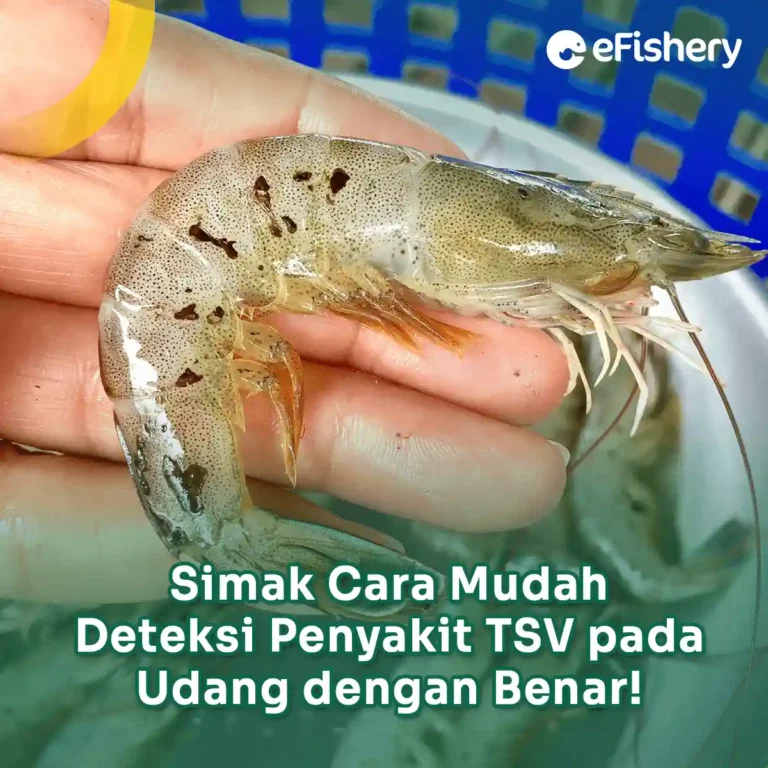Artikel Ini Telah Direview Oleh:

Anggie Nur
Magister Bioteknologi
TSV disease in shrimp or often called red tail shrimp disease is a shrimp disease that can cause significant mortality. TSV attacks on shrimp generally occur at the age of 14-40 days after stocking the shrimp seeds in ponds with a mortality rate reaching 9%. In addition, adult shrimp can also be attacked by TSV disease with a low mortality rate.
There are two phases of TSV infection in shrimp, namely the acute phase (mass shrimp death) and the chronic phase (can survive but can carry carrier TSV disease). As a result, TSV disease in shrimp has a detrimental effect on your shrimp culture. Come on, read more in this article!
What is TSV in Shrimp?
Taura Syndrome Disease (TSV) is a disease Ribonucleic Acid (RNA) shrimp which was first discovered in 1992 and comes from shrimp farming in Ecuador. Shrimp TSV has spread to large shrimp-producing countries through the transfer of fry and broodstock for aquaculture purposes or frozen shrimp feed products. TSV is classified as one of the most dangerous shrimp diseases.
Symptoms of TSV Disease
Here are some symptoms that can indicate shrimp experiencing TSV in pond ponds:
- Shrimp lethargic / not actively moving
- Reduced appetite for shrimp
- Shrimp gather at the edge of the pond pond
- Sudden death in post larval and juvenile stages
- Shrimp body pale red
- Shrimp tail is red
- Soft shrimp shell
- The existence of black spots / melanization around the body of the shrimp
These symptoms will then attack the most important parts of the shrimp, namely the gills, kidneys, brain and liver of the shrimp. This is what can cause the death of shrimp quickly in one shrimp population
Causes of TSV in Shrimp
TSV in shrimp occurs due to various factors, such as high shrimp density and unstable temperature so that the shrimp become stressed. TSV is a moderately dangerous virus that is classified as class 1 Quarantine Fish Pest and Disease (HPIK). Taura Syndrome Virus (TSV) attacks shrimp aged 14-40 days after stocking in aquaculture ponds.
How to Detect TSV in Shrimp
Detecting TSV in shrimp can be done by PCR test or Polymerase Chain Reaction. PCR is the fastest and easiest way to detect TSV. The PCR method can detect TSV disease molecularly. The way the PCR test finds TSV is by multiplying specific DNA fragments.
There are 5 ways to test using the PCR method, namely sample necropsy, extraction, amplification, electrophoresis, and visualization of the results:
Necropsy can be done by taking samples of target organs such as gills, uropods, cuticles, and shrimp swimming legs.
- Next, the extraction was carried out to separate the DNA/RNA components of the cells silica extraction kit.
- The extraction results are then amplified using a machine Polymerase Chain Reaction. This extraction consists of 5 processes namely pre-denaturation, denaturation, annealing, extension, and final extension.
- The results of the amplification will be carried out by electrophoresis. The purpose of electrophoresis is to determine the size and shape of a particle, both DNA, RNA and protein
- The results will be socialized on the UV Transluminator computer.
PCR can prevent and minimize TSV infection in shrimp culture ponds. Good and appropriate monitoring and PCR methods can determine the process of maintaining shrimp culture until maximum harvest.
Atasi Penyakit TSV dengan Berkonsultasi di Konsultasi Budidaya! GRATIS!
Need Help Regarding Shrimp Cultivation Business?
Fill in your personal data in the following form. Our team will immediately contact you via the number cellphone attached. Make sure the data entered is correct.
Are your shrimp infected with TSV? Need assistance to overcome it?
Relax, you can get assistance by consulting for FREE on the feature Cultivation Consultation from the application eFarm. eFarm is an application that helps farmers in managing shrimp farming with complete features so they can encourage maximum yields
What are you waiting for? Come on, join thousands of other shooters. Consult your cultivation constraints only at application eFarm!

Anggie Nur - Magister Bioteknologi
Anggie merupakan lulusan sarjana dan magister bioteknologi serta memiliki pengalaman riset di dunia perikanan khususnya udang
Questions Regarding TSV Disease in Shrimp
Red shrimp tail can be caused by a virus Taura Syndrome Virus (TSV) which attacks the body of the shrimp at the post larval to juvenile stages.
Some of the symptoms that can indicate shrimp experiencing TSV, namely udang lethargic / not actively moving, reduced appetite of shrimp, shrimp congregate on the edge of the pond, sudden death in the post larval and juvenile stages, the body of the shrimp is pale red, the tail of the shrimp is red, and the shell of the shrimp is soft.
- Bonami, Jean-R., Hasson, KW, Mari, J., Poulos, BT, & Lightner, DV 1997. Taura syndrome of marine penaeid shrimp: characterization of the viral agent. Journal of General Virology, 78, 313-319.
- (DAFF). Department of Agriculture Fisheries and Forestry. 2020. Infection with Taura syndrome virus (TSV). Aquatic Animal Diseases Significant To Australia: Identification Field Guide. 5th Edition.
- Dhar A and Allnutt F. 2008. Taura Syndrome Virus. Encyclopedia of Virology (Third Edition).
- Koesharyani I, Gardenia L, Mufidah T. 2015. Distribution of Taura Syndrome, Infectious Myonecrosis, and Penaeus Vannamei Nervous Virus (Tsv, Imnv, and Pvnv) Infections in Litopenaeus Vannamei Shrimp Culture in West Java, East Java, and Bali. Aquaculture Research Journal. Vol. 10(3): 415-422.
- Lightning DV. 1995. Taura Syndrome: An Economically Important Viral Disease Impacting The Shrimp Farming Industries Of The America3 Including The United States. In: Proceedings Of The Nine-ninth Annual Meeting, Reno, Nevada. Pat Campbell & Associates, Richmond, Virginia, USA. Pp. 36-52.
- Lightner D V. 1996. A Handbook Of Shrimp Pathology And Diagnostic Procedures For Disease Of Cultured Penaeid Shrimp. World Aquaculture Society, Baton. USA.
- Sarono. 1993. Pests and Quarantine Fish Diseases of the Bacterial Group. Book 2. Collaboration between the Agricultural Quarantine Center and the Faculty of Agriculture, the Department of Fisheries UGM. Yogyakarta.
- Susanti E. 2016. Identification of Tsv Virus (Taura Syndrome Virus ) in Vannamei Shrimp (Litopenaeus Vannamei) in Mempawah Hilir District Using the Pcr (Polymerase Chain Reaction) Method. Thesis. Faculty of Fisheries and Marine Science. Muhammadiyah University of Pontianak Pontianak.
